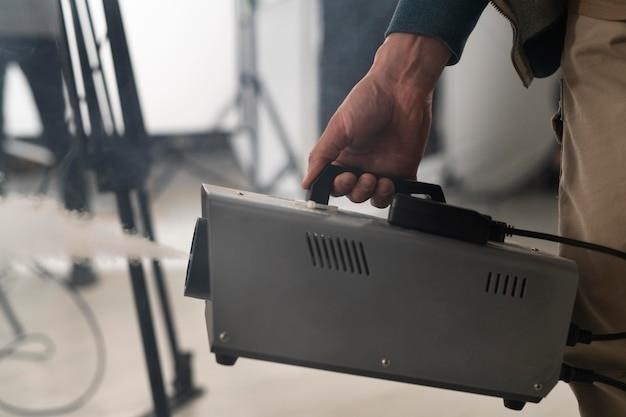Manual Transfer Case⁚ A Comprehensive Guide
This comprehensive guide delves into the world of manual transfer cases‚ exploring their function‚ types‚ benefits‚ applications‚ maintenance‚ troubleshooting‚ and selection. Whether you’re a seasoned off-road enthusiast or simply curious about this essential vehicle component‚ this guide provides valuable insights.
Introduction
In the realm of off-road vehicles and rugged adventures‚ the manual transfer case stands as a crucial component that empowers drivers to conquer diverse terrains and conditions. This versatile device serves as a bridge between the transmission and the axles‚ enabling the selection of different drive modes to optimize traction and performance. From navigating muddy trails to scaling rocky inclines‚ the manual transfer case plays a pivotal role in enhancing a vehicle’s capabilities.
For those seeking a deeper understanding of this essential component‚ this guide will unravel the intricacies of manual transfer cases‚ exploring their fundamental principles‚ types‚ applications‚ and maintenance aspects. Whether you’re an avid off-roader‚ a mechanic‚ or simply curious about the mechanics of four-wheel drive systems‚ this comprehensive exploration will equip you with valuable knowledge.

Join us as we delve into the fascinating world of manual transfer cases‚ unraveling their secrets and highlighting their significance in the realm of off-road driving.
What is a Manual Transfer Case?
A manual transfer case is a specialized gearbox that acts as an intermediary between a vehicle’s transmission and its axles‚ allowing the driver to select different drive modes for optimal traction and performance. Imagine it as a secondary gearbox that sits between the main transmission and the front and rear axles‚ offering the ability to engage or disengage the front axle‚ or even engage both front and rear axles for maximum traction.
The primary function of a manual transfer case is to distribute power from the transmission to either the rear axle (2WD mode) or both the front and rear axles (4WD mode). In essence‚ it acts as a mechanical switch that allows the driver to choose the appropriate power distribution for the driving conditions. This adaptability is particularly crucial in off-road situations where terrain variations and obstacles demand different levels of traction and torque.
Manual transfer cases are often equipped with a lever or shift knob that allows the driver to select between different drive modes‚ such as 2WD‚ 4WD High‚ and 4WD Low. These modes provide different gear ratios and power distribution‚ enabling the vehicle to tackle challenging obstacles and maintain traction on slippery surfaces.
Types of Manual Transfer Cases
Manual transfer cases come in a variety of configurations‚ each designed to suit specific vehicle applications and driving needs. Here are some common types⁚
- Two-Speed Transfer Case⁚ This type provides two gear ratios‚ typically a high-range gear for on-road driving and a low-range gear for off-road situations. The low-range gear increases torque output‚ making it easier to navigate challenging terrain.
- Three-Speed Transfer Case⁚ These transfer cases offer an additional gear ratio‚ often a “super low” gear for extremely difficult off-road conditions. This extra gear provides even greater torque multiplication for overcoming steep inclines or heavy obstacles.
- Part-Time Transfer Case⁚ These transfer cases are designed for vehicles that primarily operate in 2WD mode. They allow the driver to engage 4WD as needed for off-road situations‚ providing increased traction in challenging terrain.
- Full-Time Transfer Case⁚ These transfer cases provide 4WD operation at all times‚ automatically distributing power between the front and rear axles. They are typically found in vehicles designed for enhanced traction and handling in all driving conditions.
The specific type of manual transfer case used in a vehicle depends on factors such as the vehicle’s intended use‚ the type of terrain it will encounter‚ and the desired level of off-road capability.
How a Manual Transfer Case Works
A manual transfer case acts as a crucial intermediary between the transmission and the axles‚ enabling the driver to select different drive modes for optimal performance. Its operation involves a series of gears and shafts that engage and disengage to direct power flow to the appropriate wheels.
At its core‚ a transfer case houses a set of gears that can be shifted into various positions. These gears are connected to input and output shafts‚ which connect to the transmission and axles‚ respectively. When the transfer case is in 2WD mode‚ power flows directly from the transmission to the rear axle. When shifted into 4WD‚ the transfer case engages additional gears‚ splitting the power flow to both the front and rear axles.
The manual transfer case typically includes a lever or knob‚ allowing the driver to select different gear ratios and modes. This allows the driver to choose the most suitable drive mode for the specific driving conditions‚ whether it’s navigating slippery roads‚ tackling rough terrain‚ or simply driving on paved surfaces.
Benefits of a Manual Transfer Case
Manual transfer cases offer a range of advantages‚ particularly for vehicles designed for off-road driving‚ heavy-duty applications‚ and those requiring increased traction and control. Here are some key benefits⁚
Enhanced Traction and Control⁚ Manual transfer cases provide the ability to engage four-wheel drive‚ distributing power to all wheels. This significantly improves traction on slippery surfaces‚ uneven terrain‚ and challenging off-road conditions‚ enhancing vehicle stability and control.
Increased Ground Clearance⁚ By allowing the driver to engage a low-range gear‚ manual transfer cases enable the vehicle to crawl over obstacles with ease. This is crucial for off-road driving‚ where high ground clearance is essential for navigating challenging terrain.
Improved Towing Capacity⁚ The low-range gearing in manual transfer cases enhances the vehicle’s towing capacity‚ allowing it to handle heavier loads with greater efficiency and control. This feature is particularly valuable for trucks‚ trailers‚ and heavy-duty applications.
Versatility and Adaptability⁚ Manual transfer cases provide drivers with the ability to select the most suitable drive mode for various driving conditions. This versatility allows for optimal performance on both paved roads and off-road trails.
Durability and Reliability⁚ Manual transfer cases are known for their robust construction and durability‚ making them reliable components for demanding applications.
Applications of Manual Transfer Cases
Manual transfer cases find widespread application in a variety of vehicles and industries‚ where their ability to enhance traction‚ control‚ and towing capacity is highly valued. Here are some prominent applications⁚
Off-Road Vehicles⁚ Manual transfer cases are a standard feature in off-road vehicles such as SUVs‚ trucks‚ and Jeeps. They enable these vehicles to tackle challenging terrain‚ navigate obstacles‚ and maintain traction in slippery conditions.
Heavy-Duty Trucks⁚ Manual transfer cases are essential for heavy-duty trucks used in construction‚ mining‚ and logging industries. They provide the power and control needed to handle heavy loads‚ tow trailers‚ and navigate rough terrain.
Military Vehicles⁚ Military vehicles‚ including armored personnel carriers and tactical trucks‚ often employ manual transfer cases for their ability to operate in demanding off-road environments and handle heavy payloads.
Agricultural Vehicles⁚ Tractors and other agricultural vehicles utilize manual transfer cases to enhance traction and control when working in fields‚ towing implements‚ and navigating uneven terrain.
Emergency Response Vehicles⁚ Fire trucks‚ ambulances‚ and other emergency response vehicles may be equipped with manual transfer cases to enable them to reach remote locations and navigate challenging terrain during emergencies.
Maintenance and Repair
Regular maintenance is crucial for ensuring the longevity and optimal performance of a manual transfer case. Neglecting maintenance can lead to premature wear and tear‚ potential breakdowns‚ and costly repairs. Here’s a breakdown of essential maintenance practices and common repair issues⁚
Fluid Changes⁚ Transfer case fluid lubricates the gears and bearings‚ preventing wear and ensuring smooth operation. Follow the manufacturer’s recommended fluid change intervals‚ typically every 30‚000 to 50‚000 miles or as needed based on driving conditions.
Inspect Seals and Gaskets⁚ Regularly inspect seals and gaskets for leaks‚ which can indicate wear or damage. Replace any leaking seals or gaskets promptly to prevent fluid loss and potential internal damage.
Check for Noise and Vibration⁚ Listen for any unusual noises or vibrations emanating from the transfer case‚ which may indicate worn gears‚ bearings‚ or other internal components. Addressing these issues promptly can prevent further damage.
Inspect Drive Shaft Connections⁚ Ensure that the drive shafts connecting the transfer case to the axles are securely fastened and free of excessive wear or damage. Loose or damaged connections can result in vibrations‚ noise‚ and potential failure.
Professional Repairs⁚ For more complex issues‚ such as gear damage‚ bearing failure‚ or internal leaks‚ seek professional repair services from a qualified mechanic specializing in transfer case repairs.
Troubleshooting Common Issues
While manual transfer cases are robust components‚ they can occasionally experience issues. Identifying and addressing these problems promptly can prevent further damage and ensure continued reliable operation. Here are some common issues and troubleshooting tips⁚
Noise or Vibration⁚ If you hear unusual noises or feel vibrations coming from the transfer case‚ it could indicate worn gears‚ bearings‚ or a loose connection. Inspect the drive shaft connections‚ check for fluid leaks‚ and have the transfer case inspected by a mechanic if the issue persists.
Shifting Problems⁚ Difficulty shifting into or out of 4WD or 2WD modes could indicate a problem with the shift mechanism‚ linkage‚ or internal components. Inspect the shift linkage for proper adjustment and lubrication‚ and check for any binding or worn components. If the issue persists‚ a professional inspection is recommended.
Fluid Leaks⁚ Leaking transfer case fluid can indicate a worn seal‚ gasket‚ or damaged housing. Inspect for leaks regularly‚ and address any leaks promptly to prevent fluid loss and internal damage. Replace leaking seals or gaskets‚ and have the transfer case inspected for any underlying damage.
Grinding or Slipping⁚ Grinding or slipping when engaged in 4WD mode could indicate worn gears or clutches. Inspect the transfer case for any signs of damage or wear. In case of significant wear‚ a professional repair or replacement may be necessary.
Choosing the Right Manual Transfer Case
Selecting the appropriate manual transfer case is crucial for optimal performance and reliability; Several factors influence this choice‚ including your vehicle’s make and model‚ intended use‚ and desired off-road capabilities. Here’s a comprehensive guide to help you make an informed decision⁚
Vehicle Compatibility⁚ Ensure the transfer case is compatible with your vehicle’s transmission‚ drivetrain‚ and mounting points. Consult your vehicle’s manual or a reputable parts supplier for compatibility information.
Gear Ratios⁚ Consider the gear ratios offered by the transfer case. Lower gear ratios provide increased torque for off-road situations‚ while higher ratios are suitable for highway driving. Choose gear ratios that align with your intended use and terrain.
Transfer Case Capacity⁚ Determine the transfer case’s fluid capacity and ensure it aligns with your vehicle’s requirements. Proper fluid levels are essential for optimal performance and longevity.
Brand and Reputation⁚ Research different brands and their reputations for quality and reliability. Opt for reputable brands with a proven track record of producing durable and reliable transfer cases.
Additional Features⁚ Consider optional features such as locking differentials‚ auxiliary gear ratios‚ and electronic controls. These features can enhance off-road capabilities and provide greater versatility.
Manual transfer cases are essential components for vehicles that require off-road capabilities or increased traction in challenging conditions. Understanding their functionality‚ types‚ and maintenance is crucial for optimal performance and longevity. This comprehensive guide has provided insights into the world of manual transfer cases‚ covering everything from their operation to choosing the right one for your needs.
By carefully considering the factors discussed‚ you can make an informed decision and select a transfer case that meets your specific requirements. Regular maintenance‚ addressing potential issues promptly‚ and following manufacturer recommendations will ensure your transfer case remains in optimal condition‚ providing reliable power and traction for years to come.
Remember‚ proper maintenance and understanding of your vehicle’s transfer case are key to maximizing its potential and enjoying the benefits it offers‚ whether conquering challenging trails or simply navigating demanding terrain. This guide serves as a valuable resource for both novice and experienced off-road enthusiasts‚ empowering you to make informed choices and optimize your off-road adventures.
